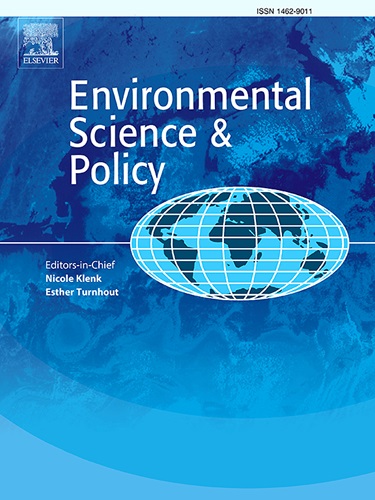Local-global linkages in biodiversity governance: The regime complex of the convention on biological diversity agenda for nature pledges
IF 5.2
2区 环境科学与生态学
Q1 ENVIRONMENTAL SCIENCES
引用次数: 0
Abstract
The trajectory of global biodiversity governance, culminating in the 2022 Kunming-Montreal Global Biodiversity Framework (KMGBF), reflects a pivot toward transformative change through a “whole-of-society” (WoS) approach. This approach integrates traditional multilateral negotiations with various self-organizing governance initiatives across the public, civil, and business spheres, forming additional layers within a biodiversity regime complex. While praised for its flexibility, horizontal linkages, and adaptability, an open question remains: Has this regime complex effectively delivered on its transformative promises? Using 718 biodiversity pledges submitted to the Action Agenda for Nature under the Convention on Biological Diversity—representing 1086 actors and 4109 connections—we applied social network and discourse analysis to map dynamic actor interactions and examine how they shape regime dynamics. Our findings reveal the emergence of a “middle-out” governance space, where non-state and sub-national actors act as intermediaries linking global commitments to local implementation. By visualizing the diffusion of participation, we identify potential leverage points where these actors can step forward as agents of change within the biodiversity regime. Yet despite these advances, network fragmentation persists—marked by duplication, misalignment, and weak cross-scale connectivity. Divergent discourses and weak ties between biodiversity status and actions further hinder systemic coherence. We argue that the regime complex must be reconceptualized beyond horizontal linkages to include vertical dimensions of governance. This study contributes to emerging network approaches in global biodiversity governance by identifying governance gaps and highlighting opportunities for systemic transformation. Strengthening alignment across levels and empowering middle-out actors are essential steps toward translating ambitious global biodiversity goals into effective, inclusive, and locally grounded actions.
生物多样性治理中的地方-全球联系:生物多样性公约自然认捐议程的制度综合体
以2022年《昆明-蒙特利尔全球生物多样性框架》(KMGBF)为高潮的全球生物多样性治理轨迹,反映了通过“全社会”(WoS)方法实现变革性变革的核心。这种方法将传统的多边谈判与公共、民间和商业领域的各种自组织治理倡议相结合,在生物多样性制度综合体中形成额外的层次。虽然它的灵活性、横向联系和适应性受到称赞,但一个悬而未决的问题仍然存在:这个政权综合体是否有效地兑现了它的变革承诺?利用《生物多样性公约》下提交给《自然行动议程》的718项生物多样性承诺——代表1086个行动者和4109个联系——我们应用社会网络和话语分析来绘制动态行动者互动图,并研究它们如何塑造制度动态。我们的研究结果揭示了一个“中间”治理空间的出现,在这个空间中,非国家和次国家行为体充当了将全球承诺与地方实施联系起来的中介。通过可视化参与的扩散,我们确定了潜在的杠杆点,这些行动者可以在生物多样性制度中作为变革的推动者向前迈进。然而,尽管取得了这些进步,网络碎片化仍然存在,其特征是重复、不对齐和跨规模连接薄弱。不同的话语和生物多样性状况与行动之间的弱联系进一步阻碍了系统的一致性。我们认为,体制复合体必须重新概念化,超越水平联系,包括治理的垂直维度。本研究通过识别治理差距和强调系统转型的机会,为全球生物多样性治理中的新兴网络方法做出了贡献。加强各层面的协调,增强中间行为体的权能,是将雄心勃勃的全球生物多样性目标转化为有效、包容和立足地方的行动的关键步骤。
本文章由计算机程序翻译,如有差异,请以英文原文为准。
求助全文
约1分钟内获得全文
求助全文
来源期刊

Environmental Science & Policy
环境科学-环境科学
CiteScore
10.90
自引率
8.30%
发文量
332
审稿时长
68 days
期刊介绍:
Environmental Science & Policy promotes communication among government, business and industry, academia, and non-governmental organisations who are instrumental in the solution of environmental problems. It also seeks to advance interdisciplinary research of policy relevance on environmental issues such as climate change, biodiversity, environmental pollution and wastes, renewable and non-renewable natural resources, sustainability, and the interactions among these issues. The journal emphasises the linkages between these environmental issues and social and economic issues such as production, transport, consumption, growth, demographic changes, well-being, and health. However, the subject coverage will not be restricted to these issues and the introduction of new dimensions will be encouraged.
 求助内容:
求助内容: 应助结果提醒方式:
应助结果提醒方式:


